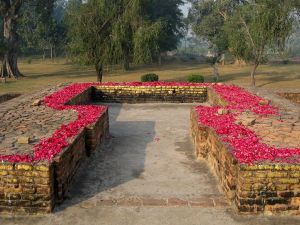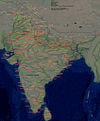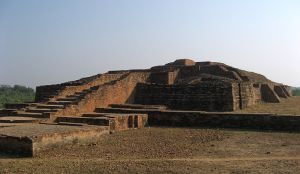Sravasti
Coordinates:

Srāvastī or Sāvatthī (Hindi: श्रावस्ती), a city of ancient India, was one of the six largest cities in India during Gautama Buddha's lifetime. The city was located in the fertile Gangetic plains in the present day's Gonda district of Uttar Pradesh. Jetavana monastery was a famous monastery close to Savatthi.
Origin of Sravasti

According to the epic Ramayana, Sravasti was a new city created for Lava (the son of Raghava Rama). Rama divided his Kosala Kingdom into two parts and installed his son Lava at Sravasti and another son Kusha at Kushavati, another town in Kosala. According to the Mahabharata, the origin of Sravasti lies with the legendary king Shravasta. According to Buddhist tradition, the city was called Savatthi because the sage Savattha lived there. Another tradition says there was a caravanserai there, and people meeting there asked each other what they had ("Kim bhandam atthi?"), then replied "Sabbam atthi" (meaning "we have all things", as in everything). And the name of the city was based on the reply[1].
Sravasti in the Buddha's time
Savatthi was located on the banks of the river Aciravati (now called the Rapti river). It was the capital city of the kingdom of Kosala, and its king was called Pasenadi, who was a disciple of Buddha. It is a beautiful city with vast amounts of agriculture and diversity. Buddhaghosa says [2] that, in the Buddha's day, there were fifty seven thousand families in Savatthi, and that it was the chief city in the country of Kasi Kosala, which was three hundred leagues in extent and had eighty thousand villages. He stated the population of Sávatthi to have been 180 million [3]. The road from Rajagaha to Savatthi passed through Vesali, and the Parayanavagga [4] gives as the resting places between the two cities: Setavya, Kapilavatthu, Kusinara, Pava and Bhoganagara. Further on, there was a road running southwards from Savatthi through Saketa to Kosambi. Between Saketa and Savatthi was located Toranavatthu[5].
The Buddha passed the greater part of his monastic life in Savatthi. His first visit to Savatthi was at the invitation of Anathapindika, whom he met in Rajagaha. The main monasteries in Sravasti were the Jetavana and the Pubbarama. Savatthi also contained the monastery of Rajakarama, built by Pasenadi, opposite Jetavana. Not far from the city was a dark forest called the Andhavana, where some monks and nun went to live. Outside the city gate of Savatthi was a fisherman's village of five hundred families[6].
The chief patrons of the Buddha in Savatthi were Anathapindika, Visakha, Suppavasa and Pasenadi[7]. When Bandhula left Vesali he came to live in Savatthi.
Woodward states[8] that, of the four Nikayas, 871 suttas are said to have been preached in Savatthi; 844 of which are in Jetavana, 23 in the Pubbarama, and 4 in the suburbs of Savatthi. These suttas are made up of 6 in the Digha Nikaya, 75 in the Majjhima Nikaya, 736 in the Samyutta Nikaya, and 54 in the Anguttara Nikaya. The Commentaries state that the Buddha spent twenty five rainy seasons in Sávatthi, this leaving only twenty to be spent elsewhere. Of the 25 rainy seasons Buddha lived in Sravasti[9], he spent 19 in the monastery named Jetavana, and 6 in the monastery called Pubbarama. Thus, Sravasti is the place where Buddha lived the longest amount of time, and it is the place where he gave the largest amount of discourses and instructions.
Savatthi is the place where the Twin Miracle (Pali:Yamaka Patihara) took place, in which Buddha made a demonstration of his supernatural powers for the purpose of silencing certain believers of other faiths who proclaimed that the Buddha was incapable of performing supernatural miracles. The Buddhist commentarial tradition says that Savatthi is the scene of each Buddha's Yamaka pátiháriya[10]; Gotama Buddha performed this miracle under the Gandamba tree.
The Chinese Pilgrim Hiouen Thsang found the old city in ruins, but recorded the sites of various buildings[11].
Current Sravasti
| Pilgrimage to Buddha's Holy Sites |

|
| The Four Main Sites |
|---|
| Lumbini · Bodh Gaya Sarnath · Kushinagar |
| Four Additional Sites |
| Sravasti · Rajgir Sankissa · Vaishali |
| Other Sites |
| Patna · Gaya Kausambi · Mathura Kapilavastu · Devadaha Kesariya · Pava Nalanda · Varanasi |
Of the ancient Savatthi the city walls are still standing. Within these, the remains of 3 ancient buildings can be visited: Angulimala's stupa, Anathapindika's stupa, and an old temple dedicated to a Jain Tirthankara. Outside of Savatthi is located the stupa where the Twin Miracle (Pali:Yamaka Patihara) took place. The site of Jetavana monastery is the main pilgrim destination, with meditation and chanting mainly done at the Gandhakuti (Buddha's hut) and the Anandabodhi tree. Buddhist monasteries from the following countries have been constructed at Sravasti: Thailand, South Korea, Sri Lanka, Myanmar, Tibet and China.
Buddhist monks meditating under the Anandabodhi tree.
Notes
ReferencesISBN links support NWE through referral fees
External links
- Entry on Savatthi in the Buddhist Dictionary of Pali Proper Names
- Description of Sravasti by the Chinese pilgrim monk Faxian (399-414 AC)
- Suttas spoken by Gautama Buddha concerning Sravasti: (more)
Credits
New World Encyclopedia writers and editors rewrote and completed the Wikipedia article in accordance with New World Encyclopedia standards. This article abides by terms of the Creative Commons CC-by-sa 3.0 License (CC-by-sa), which may be used and disseminated with proper attribution. Credit is due under the terms of this license that can reference both the New World Encyclopedia contributors and the selfless volunteer contributors of the Wikimedia Foundation. To cite this article click here for a list of acceptable citing formats.The history of earlier contributions by wikipedians is accessible to researchers here:
The history of this article since it was imported to New World Encyclopedia:
Note: Some restrictions may apply to use of individual images which are separately licensed.









